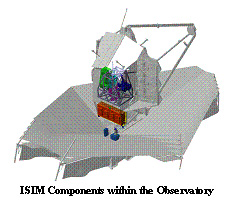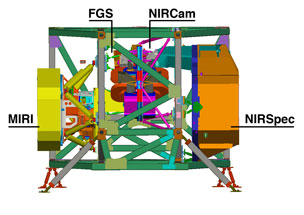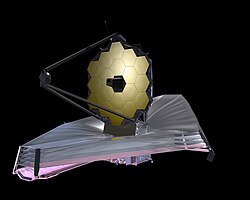(Over 1000 people in more than 17 countries are developing the James Webb Space Telescope. Shown here are team members in front of the JWST full-scale model at the Goddard Space Flight Center in Greenbelt, Maryland. )
Edited by:The James Webb Space Telescope (JWST) is a large, infrared-optimized space telescope, scheduled for launch in 2014. JWST will find the first galaxies that formed in the early Universe, connecting the Big Bang to our own Milky Way Galaxy. JWST will peer through dusty clouds to see stars forming planetary systems, connecting the Milky Way to our own Solar System. JWST's instruments will be designed to work primarily in the infrared range of the electromagnetic spectrum, with some capability in the visible range.
Edited by:The James Webb Space Telescope (JWST) is a large, infrared-optimized space telescope, scheduled for launch in 2014. JWST will find the first galaxies that formed in the early Universe, connecting the Big Bang to our own Milky Way Galaxy. JWST will peer through dusty clouds to see stars forming planetary systems, connecting the Milky Way to our own Solar System. JWST's instruments will be designed to work primarily in the infrared range of the electromagnetic spectrum, with some capability in the visible range.
JWST will have a large mirror, 6.5 meters (21.3 feet) in diameter and a sunshield the size of a tennis court. Both the mirror and sunshade won't fit onto the rocket fully open, so both will fold up and open once JWST is in outer space. JWST will reside in an orbit about 1.5 million km (1 million miles) from the Earth.
For Scientists
This page and the set of links available from this page are for the use of astronomers who would like to learn more about using JWST for their research programs. A detailed description of the science capabilities and instruments on JWST can be found in the Space Science Reviews paper (external link) by Gardner et. al. A brief synopsis of the JWST science themes can be obtained here. White papers written by the JWST Science Working Group can be found here.
For technical information about the status, design and plans for JWST, you can go to http://spie.org and search for “webb" and "jwst”. On that site there are more than 500 technical articles about JWST. (Note there is a fee per article on that site without an institutional subscription.)
You may also be interested in visiting the Images & Videos section of our website.
Once it launches in 2013, the James Webb Space Telescope will be able to communicate and connect with the Earth thanks to a modified "off-the-shelf" computer software system that has been recently and successfully tested.
The customized off-the-shelf computer system, the Raytheon Corporation’s ECLIPSE product, will be used to send commands to the Webb telescope and collect its telemetry data.
 Image right: Artist's conception of the James Webb Space Telescope in orbit. Click image for higher resolution. Credit: Canadian Space Agency
Image right: Artist's conception of the James Webb Space Telescope in orbit. Click image for higher resolution. Credit: Canadian Space Agency
Telemetry means that a spacecraft in orbit makes automatic measurements and transmits them to the Earth using a radio signal. The information sent also includes information describing the health of the spacecraft. It's important for the engineers on the ground receiving the information, to know that the James Webb Space Telescope is working well. If it isn't, they need to try and fix it from the ground, sending commands to the spacecraft's computer system using a radio signal, so it can repair its software.
Two companies worked together to modify the telemetry system: Northrop Grumman and the Raytheon Corporation. Recently, they completed the tests that made sure it worked properly and specifically for the James Webb Space Telescope. It turns out that the same modifications they made for the Webb telescope can be used in another upcoming space satellite called "NPOESS."
This is the first time a team included engineers from two different spacecraft programs, the Webb telescope and the NPOESS satellite. Alexis Livanos, Corporate Vice President and President of Northrop Grumman’s Space Technology sector said "Two customers with two separate programs were willing to trust our collaboration and teamwork to align schedules so that the same system could be used."
The key for the success was testing the telemetry system. So, Northrop Grumman and Raytheon increased test requirements to bring together the way two different satellites communicate and the needs of their users. Software requirements were checked on the spacecraft and ground equipment simulators at Northrop Grumman over a four-week period that ended in August.
 Image right: The Webb telescope sends data to ground stations on Earth, which route the data to the Space Telescope Science Institute for processing and distribution. Click image for higher resolution. Credit: STScI
Image right: The Webb telescope sends data to ground stations on Earth, which route the data to the Space Telescope Science Institute for processing and distribution. Click image for higher resolution. Credit: STScI
That testing was the last step in a process that took four years of development at Raytheon. Raytheon was responsible for developing this system for Northrop Grumman. Engineers and scientists at Northrop are actually building the spacecraft. During the tests, 1300 requirements were met. The tests checked the ability to send commands from equipment to equipment, receive telemetry (or communications), and to control and monitor the test hardware.
Recently, the modified telemetry software was delivered to scientists and engineers at the Goddard Space Flight Center who will use it to develop, test, and add it into their instruments for the James Webb Space Telescope.
The James Webb Space Telescope, designed to succeed the Hubble Space Telescope, will be NASA's premier space observatory. Northrop Grumman is the prime contractor, leading a team in the telescope’s design and development under contract to NASA Goddard. NPOESS is the nation's next-generation low-Earth orbiting remote sensing system and will provide environmental data to military and civilian users. Both are scheduled for launch in 2013.
Instruments
The Integrated Science Instrument Module, or ISIM, is the heart of the JWST, what engineers call the main payload. This is the unit that will house the four main JWST instruments. The ISIM is like a chassis in a car providing support for the engine and other components.
The four instruments that attach to the ISIM are:
Mid-Infrared Instrument, or MIRI - provided by the European Consortium with the European Space Agency (ESA), and by the NASA Jet Propulsion Laboratory (JPL)
Near-Infrared Camera, or NIRCam - provided by the University of Arizona
Near-Infrared Spectrograph, or NIRSpec - provided by ESA, with components provided by NASA/GSFC.
Fine Guidance Sensor, or FGS - provided by the Canadian Space Agency. The FGS contains a dedicated Guider and a Tunable Filter Camera. Goddard Space Flight Center provides the ISIM infrastructure subsystems required for operation of these instruments. These include the ISIM Structure Subsystem; ISIM Thermal Control Subsystem; ISIM Control and Data Handling Subsystem; ISIM Flight Software; and ISIM Harness Assemblies.
As you can imagine, integrating four major instruments and numerous subsystems into one payload, the ISIM, is a daunting endeavor. To simplify integration, engineers have divided the ISIM into three regions.
The "region 1" component is the cryogenic instrument module. This chills the detectors down to 39 K, a necessary first-stage cooling effort so that the spacecraft's own heat doesn't interfere with the infrared light (a form of heat) detected from distant cosmic sources. The ISIM/OTE Thermal Management Subsystem provides passive cooling. Other devices will get the detectors even colder.
Arip Nurahman
Guru dan Dosen Profesional, amin cita-citaku
The customized off-the-shelf computer system, the Raytheon Corporation’s ECLIPSE product, will be used to send commands to the Webb telescope and collect its telemetry data.
 Image right: Artist's conception of the James Webb Space Telescope in orbit. Click image for higher resolution. Credit: Canadian Space Agency
Image right: Artist's conception of the James Webb Space Telescope in orbit. Click image for higher resolution. Credit: Canadian Space AgencyTelemetry means that a spacecraft in orbit makes automatic measurements and transmits them to the Earth using a radio signal. The information sent also includes information describing the health of the spacecraft. It's important for the engineers on the ground receiving the information, to know that the James Webb Space Telescope is working well. If it isn't, they need to try and fix it from the ground, sending commands to the spacecraft's computer system using a radio signal, so it can repair its software.
Two companies worked together to modify the telemetry system: Northrop Grumman and the Raytheon Corporation. Recently, they completed the tests that made sure it worked properly and specifically for the James Webb Space Telescope. It turns out that the same modifications they made for the Webb telescope can be used in another upcoming space satellite called "NPOESS."
This is the first time a team included engineers from two different spacecraft programs, the Webb telescope and the NPOESS satellite. Alexis Livanos, Corporate Vice President and President of Northrop Grumman’s Space Technology sector said "Two customers with two separate programs were willing to trust our collaboration and teamwork to align schedules so that the same system could be used."
The key for the success was testing the telemetry system. So, Northrop Grumman and Raytheon increased test requirements to bring together the way two different satellites communicate and the needs of their users. Software requirements were checked on the spacecraft and ground equipment simulators at Northrop Grumman over a four-week period that ended in August.
 Image right: The Webb telescope sends data to ground stations on Earth, which route the data to the Space Telescope Science Institute for processing and distribution. Click image for higher resolution. Credit: STScI
Image right: The Webb telescope sends data to ground stations on Earth, which route the data to the Space Telescope Science Institute for processing and distribution. Click image for higher resolution. Credit: STScIThat testing was the last step in a process that took four years of development at Raytheon. Raytheon was responsible for developing this system for Northrop Grumman. Engineers and scientists at Northrop are actually building the spacecraft. During the tests, 1300 requirements were met. The tests checked the ability to send commands from equipment to equipment, receive telemetry (or communications), and to control and monitor the test hardware.
Recently, the modified telemetry software was delivered to scientists and engineers at the Goddard Space Flight Center who will use it to develop, test, and add it into their instruments for the James Webb Space Telescope.
The James Webb Space Telescope, designed to succeed the Hubble Space Telescope, will be NASA's premier space observatory. Northrop Grumman is the prime contractor, leading a team in the telescope’s design and development under contract to NASA Goddard. NPOESS is the nation's next-generation low-Earth orbiting remote sensing system and will provide environmental data to military and civilian users. Both are scheduled for launch in 2013.
Instruments
The Integrated Science Instrument Module, or ISIM, is the heart of the JWST, what engineers call the main payload. This is the unit that will house the four main JWST instruments. The ISIM is like a chassis in a car providing support for the engine and other components.
The four instruments that attach to the ISIM are:
 |  |
The "region 1" component is the cryogenic instrument module. This chills the detectors down to 39 K, a necessary first-stage cooling effort so that the spacecraft's own heat doesn't interfere with the infrared light (a form of heat) detected from distant cosmic sources. The ISIM/OTE Thermal Management Subsystem provides passive cooling. Other devices will get the detectors even colder.
The "region 2" component is the ISIM Electronics Compartment, which provides the mounting surfaces and ambient thermally controlled environment for the instrument control electronics.
The "region 3" component, located within the Spacecraft Bus, is the ISIM Command and Data Handling subsystem, with integral ISIM flight Software, and the MIRI cryocooler compressor and control electronics.
Download the ISIM Fast Facts .pdf file. This item is of a technical nature.  Artist's impression of JWST | |
| General information | |
|---|---|
| Organization | NASA / ESA / CSA |
| Major contractors | Ball Aerospace Northrop Grumman |
| Launch date | 2014 |
| Launched from | Guiana Space Centre ELA-3 Kourou, French Guiana |
| Launch vehicle | Ariane 5 |
| Mission length | 5 years (design) 10 years (goal) |
| Mass | 6,200 kg (14,000 lb) |
| Orbit period | 1 year |
| Location | 1.5×106 km (Lagrangian point L2) |
| Telescope style | Three Mirror Anastigmat |
| Wavelength | 0.6 to 28 µm (infrared) |
| Diameter | ~6.5 m (21 ft) |
| Collecting area | 25 m2 (270 sq ft) |
| Focal length | 131.4 m (431 ft) |
| Instruments | |
| NIRCam | Near IR Camera |
| NIRSpec | Near IR Spectrograph |
| MIRI | Mid IR Instrument |
| FGS | Fine Guidance Sensor |
| Website | www.jwst.nasa.gov |
References
- ^ jwst.nasa.gov
- ^ Maggie Masetti; Anita Krishnamurthi (2009). "JWST Science". NASA. http://www.jwst.nasa.gov/science.html. Retrieved 2009-05-02.
- ^ Maggie Masetti; Anita Krishnamurthi (2009). "Why does JWST need to be at L2 publisher=NASA". http://www.jwst.nasa.gov/l2_moreinfo.html. Retrieved 2009-05-02.
- ^ a b Gardner, p. 588.
- ^ a b Gardner, table XV, p. 597
- ^ "JWST Passes NTAR". STScI. http://www.stsci.edu/jwst/project_highlights/tnar.html. Retrieved 2008-07-05.
- ^ a b John Mather. "James Webb Space Telescope (JWST)" (PDF). National Academy of Science. http://www7.nationalacademies.org/bpa/CAA_Nov2005_Presentation_Mather.pdf. Retrieved 2008-07-05.
- ^ "European agreement on James Webb Space Telescope’s Mid-Infrared Instrument (MIRI) signed". Press release. 9 June 2004. http://www.esa.int/esaSC/Pr_10_2004_s_en.html. Retrieved 2009-05-06.
Arip Nurahman
Guru dan Dosen Profesional, amin cita-citaku
























